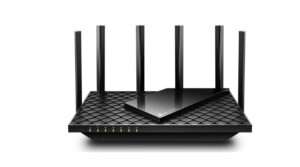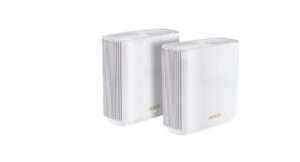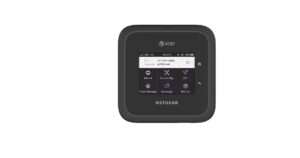Is it faster – TP-Link AXE5400 tri-band WiFi 6E router (Archer AXE75)? The Archer AXE75 is a good upgrade from a Wi-Fi 5 router that comes with all the add-ons you typically get with a standalone router, such as file sharing, basic parental controls, and a couple VPN tools. The main highlight of this router is its 6 GHz connection, which is fantastic if your device can use it. However, don’t expect superfast multi-gig Wi-Fi speeds from the new band because the AXE75’s internet port keeps you grounded under a gigabit. You can find similarly priced Wi-Fi 6E routers with faster speeds on the market. Get more in TP-Link AXE5400 tri-band WiFi 6E router (Archer AXE75) review.
Pros & cons
Pros
- Accelerated 5GHz and 6GHz speeds
- 160MHz support on both 5GHz and 6GHz
- For many, the free HomeShield controls are sufficient.
- VPN Client assistance
- Simple to set up
- Ready for mesh
- USB 3.0 port for exchanging files and media
- Affordably priced, long-range 6E mesh WiFi
Cons
- No multi-gig Ethernet
- Some features require a subscription
- Large swings in latency, including packet loss
TP-Link AXE5400 tri-band WiFi 6E router (Archer AXE75) Specs
- Standard Tri-band Wi-Fi 6E
- CPU 1.7GHz quad-core
- Capacity 6 streams, OFMDA, DFS, beamforming
- Max speed 6GHz: 2,402Mb/s, 5GHz: 2,402Mb/s, 2.4GHz: 574Mb/s
- Protocols IPv4, IPv6
- Range 2-3-bedroom houses
- Antennas 6x adjustable, external
- Ports 1x Gigabit WAN, 4x Gigabit LAN, 1x USB-A 3.0
- Dimensions 272.5mm × 147.2mm × 49.2mm
- Processor 1.7 GHz quad-core Processor Row 0 – Cell 2
- Operating Frequency 2.4 GHz / 5 GHz / 6 GHz Row 1 – Cell 2
- Data Rates 2.4 GHz: 574 Mbps (802.11ax); 5 GHz: 2402 Mbps (802.11ax); 6 GHz: 2402 Mbps (802.11ax) Row 2 – Cell 2
- Ports (4) gigabit Ethernet ports, (1) gigabit WAN port, (1) USB 3.0 port Row 3 – Cell 2
- Encryption WPA, WPA2, WPA3, WPA/WPA2-Enterprise (802.1x) Row 4 – Cell 2
- Wi-Fi Technology Beamforming, High-Power FEM, OFDMA, Airtime Fairness, DFS Row 5 – Cell 2
- Dimensions 10.7″ × 5.8″ × 1.9″ (not counting antennas) Row 6 – Cell 2
- Price $179.00+
Price
You can purchase one unit TP-Link AXE5400 tri-band WiFi 6E router (Archer AXE75) at $179 from online retailer.
TP-Link AXE5400 tri-band WiFi 6E router (Archer AXE75) review
Design
Not including its six foldable antennae, the TP-Link Archer AXE75 is 10.7″ × 5.8″ × 1.9″. It essentially resembles a little tray in both size and shape.
Ports
Each node has three gigabit ethernet ports on the back, one of which needs to be used to connect your modem to the primary mode. Provided your home is (or will be) configured appropriately, you can also use the ports to run Ethernet backhaul.The device has a WPS button, an LED power button (a great addition for people who get tired of needless bright lights on devices), and an on/off WiFi button on the back.
WiFi chip
Similar to the AX75, the AXE75 has a 1.7GHz quad-core CPU and 512MB of RAM. However, it also has Wi-Fi 6E circuitry, which enables it to function on the 2.4GHz and 5GHz bands in addition to the 6GHz radio band.
Band
Sixth-generation WiFi operates at a frequency of six GHz instead of five, and it can support up to seven 160 MHz bands simultaneously. And while the majority of new flagship-tier phones, along with certain laptops and tablets, have started to pack in the tech, just a small number of devices presently support Wi-Fi 6E.
Data transfer rate
According to its model number, AXE5400, this router has a theoretical maximum data rate of 574 Mbps on the 2.4GHz band, 2,402 Mbps on the 5GHz band, and 2,402 Mbps on the 6GHz band. Additionally, it supports Wi-Fi 6 features like 160MHz channel capacity, MU-MIMO simultaneous data streaming, direct-to-client beamforming, OFDMA (orthogonal frequency-division multiple access) transmissions, Dynamic Frequency Selection (DFS), and WPA3 encryption.
Deco app
Setting up the Deco XE75 was simple; it took me only 16 minutes from the time I took the plastic film out of the box. After creating a TP-Link account and downloading the Deco companion app, you will be led through the quick setup procedure. All you have to do to get started is plug in the first node, let the app know if you have any ISP-specific requirements, and provide a name and password for your network.
The buttons for Home, Clients, Security, Family, and Tools are located along the bottom of the Home screen. From anywhere in the app, you may get back to this screen by tapping the Home button. Pressing the Clients button brings up a list of all the devices you have linked. You may see details like the IP and MAC addresses of a customer by tapping their name. Additionally, you can activate parental restrictions, prohibit that client from accessing the internet, and activate QoS settings that prioritize the bandwidth of the client device.
TP-Link AXE5400 tri-band WiFi 6E router (Archer AXE75) performance review
Speeds averaged 270 Mbps down near the main node, and I was still only getting 260 Mbps in my two-story office. Even in the notorious signal dead zone that is my rear bedroom, SpeedTest download benchmarks dropped to about 220 Mbps. Ping times were likewise reliable, to the extent that I believe a two-point mesh would have been adequate.
The 5GHz close-proximity test yielded 918Mbps for the AXE75. Though it trailed the Asus ROG Rapture GT-AXE16000 (938Mbps) and the Netgear RAXE500 (936Mbps), it was quicker than the Linksys Hydra Pro 6E (750Mbps). The AXE75 outperformed the Linksys Hydra Pro 6E (303Mbps) with a 30-foot test score of 360Mbps, although it was much slower than the Asus ROG Rapture GT-AXE16000 (521Mbps) and the Netgear RAXE500 (530Mbps).
The AXE75’s 44MBps write speed was 11MBps slower than the Linksys Hydra Pro 6E (55MBps) and slightly slower than the Asus ROG Rapture GT-AXE16000 (48MBps). At 70MBps, the Netgear RAXE500 outperformed all of them. The Linksys Hydra Pro 6E (57MBps) and the Netgear RAXE500 (68MBps) were both too fast for the AXE75 (46MBps) to keep up with the Asus ROG Rapture GT-AXE16000 (45MBps) in the read test.
Subscription
Additionally, TP-Link sells a version of Homeshield that is paid for and delivers more data on the websites users visit and enhanced security against breaches. It claims that doing this will prevent “teen internet addiction (sic),” “attacks from IoT devices (sic),” and “intrusion by cyber viruses (sic).” I’m not sure if Homeshield Pro offers enough value to justify signing up for the extras, but it costs $5.99 a month or $55 for a year.
TP-Link AXE5400 tri-band WiFi 6E router (Archer AXE75) customer review
Easy setup, great performance, expensive
Easy setup, great signal strength, and outstanding transfer speeds. The device has an offset power plug on the back, allowing installation in either direction. This allowed me to install it hanging down from my plug so I could still use the other socket. It doesn’t have anything securing it in place, so if your outlet is loose, then this device may fall out. Choosing this device was nearly the same price as buying another router that could be configured to do the same job. Routers are larger and more complicated to configure as a repeater. If you have the technical know-how and the space for installation, I would recommend considering a router over this device.
By Martin at Best Buy
TP-Link AXE5400 tri-band WiFi 6E router (Archer AXE75) review alternative
Amazon Eero Max 7
The Eero Max 7 from Amazon can be the right choice for you if you want lightning-fast speeds and money is practically not an issue. It was one of the original Wi-Fi 7 routers, and in our tests, it achieved throughput speeds of up to 1,130 Mbps, however those figures significantly decreased at longer ranges. The speeds were higher than those of most Wi-Fi 6E routers, even at 5-GHz.
But in order to fully utilize the Eero Max 7’s bandwidth, you’ll require client devices, such as a computer, phone, or tablet, that are equipped with a Wi-Fi 7 radio. The majority of modern devices still lack the feature.
Because the Eero Max 7 is a mesh router, you can purchase two or three nodes if you have a larger home and want better reception. The Eero mobile app makes it simple to add and set up nodes. Regretfully, there isn’t even a web interface.
With the help of the app’s Eero Labs feature, you may activate WPA3 security, obtain optimizations for games or films, and enable local DNS caching. If you pay $99 a year for Eero Plus, you can also get services like VPN, content filters, ad blocking, and historical data.



